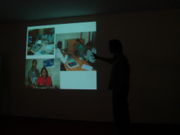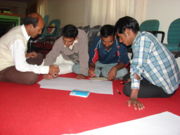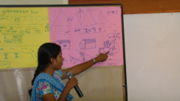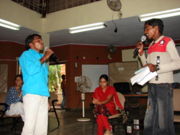Community Media/Conceptual Clarity
Maraa has devised a two day training module on conceptual clarity for Community Radio for participants, who comprise mainly of management, production team and some volunteers. This particular module has been field tested for four community radio stations in India, namely Namma Dhwani Community Radio (in Budikote Village, Kolar, Karnataka), Radio Bundelkhand (in Orchha, Madhya Pradesh), Radio Vikalp (Garhwa Village, Meral Block, Jharkhand) and Kumaun Vani Radio (in Supi Village, Mukteshwar District, Uttarakhand). This module was built and implemented as a part of the Flagship Project for Setting up Community Radio in the Tribal Regions of India, with support from the International Program for Development of Communication (IPDC), a major UN Forum set up by member countries to promote pluralism and democratization of media in Third World Countries.
Contents
Workshop Aim
To help participants arrive at a localized definition and conception of community radio in their geography, culture and specific context, however, satisfying policy condition as stipulated by Government of India.
Organizational Strategy
The organizational strategy to which this workshop will contribute to is community radio being used as a strategic tool to deepen engagement with communities with which the NGO is working presently, and to bring about greater participation from people in the "development" process.
To contribute to this strategy, the aim of this workshop is to make/create/update a localized definition and conception of community radio which is specific to culture, geography and context in order to start the process of setting up a truly participatory and community based radio station in the interests of the local people, where each NGO is working.
Workshop Objectives
- Review of existing definitions used by actual community radio stations
- Review of some examples of community radio stations, and how they have arrived at their definitions
- Producing new definitions
- Assessment and next steps
Who
The kind of people who will participate in this kind of a workshop is difficult to identify. One one hand, the participant must be familiar enough with the nuts and bolts of his/her NGO to be able to define community radio in its context, geography and culture. On the other hand, the person must also be familiar with the people of his/her community, so he or she can be a legitimate representative of the community, and be able to start work on their definition without alienating people in their working area. We recommend that mid-level staff, who straddle both responsibilities, internal and field work, particularly, those who will be working closely with the community radio station are encouraged to attend this workshop. The invitation to this workshop would be sent to NGOs who are keen to apply for community radio, but are not sure what exactly it means, what are the benefits, what is the process to be undertaken etc. In short, they will be potential community radio stations! However, since this is only the first step, it is advisable to do a series of similar workshops with the same participants, to ensure continuity, and uninterrupted understanding of the concept.
How Long
This particular workshop will be of two full days in duration, with a variety of presentations, exercises and discussions. It could be shortened or lengthened depending on circumstances, but given a choice, two days would be ideal.
Introduction of participants
- Session Chair: Main Facilitator (s)
- Duration: 30 minutes
- Purpose: To get participants to know each other beyond names, to break formalities and tensions, and to get participants to participate immediately in the workshop
Activities
Here participants are paired up and each participant is asked to introduce the other participant. They are expected to find out information which is not just factual but also to find out likes and dislikes, hobbies, talents and so on. Further, the participants are also expected to introduce their partner in an interesting way. This way, we tell the participants, that from now on, since they are going to be radio practitioners, they should be getting used to finding out information which is not just run of the mill, and secondly learn to present it in a humorous or interesting fashion so as to capture people's attention
Radio through photographs
- Session Chair: Main facilitator (s)
- Duration: 30 minutes
- Purpose: To get participants started on thinking about the sheer diversity of radio, and start to locate community radio on the map of media and its structures. To give participants, a sense of history to what they are going to begin in the next few months.
Activities
Here, we show the participants a power point presentation on the journey of radio. In our case, we start off by showing them pictures of All India Radio, the public broadcaster, and the colonial context in which it began. So public radio was mainly for disseminating government information to the public. This tradition and philosophy remained intact even after India gained independence. The structure and regulations were unchanged, in fact, even after All India gained autonomy in 1997, and came under the aegis of Prasar Bharathi, a independent broadcasting body, fashioned on the lines of BBC. Then we take the participants through the journey of economic liberalization of India in 1990, which among other things, opened up the FM radio sector as well. So in a few years, our government started auctioning frequencies, and businesses had to pay a fee over and above their purchase cost. This fee was incremented by 15% annually. Pretty soon, most commercial radio stations could not cope up with the steep cost, and many closed down citing bankruptcy. Today, the government retains the auction model, but annual fees are based on percentage of profits/revenue. We explain that this model of radio has about a 3% of market share at present, and is heavily dependent on advertising for its profits and functioning, since radio is a free technology and you can't really charge people for listening. In India, businesses like Reliance have invested heavily into radio. We then talk briefly about the content which is aired on these two kinds of radio stations and experiences of participants who have tuned into either of these radio station types.
Having made this introduction, we show them some pictures of community radio initiatives in India, like Namma Dhwani, DDS, KMVS and so on. We tell the participants that in 2004, the Indian government opened up community broadcasting but only for educational institutions. The management of these stations are with the educational institutions and the programming is mainly educational. Only in 2006, did the Indian government open up community radio for non profit institutions. Using the examples of some initiatives given above, we show demonstrations of community based programming, management and ownership, feedback, development communication and other concepts. We then go into some key concerns of community radio like management, sustainability and so on, but these are not explored in depth. We just say that these will be explored in depth later. The last part of this session is kept for interactive discussion wherein participants can ask us questions or doubts they have on this information.
Note: If you want a copy of this presentation, please mail us at info at maraa dot in, and we can mail it to you
Community Radio Policy
- Session Chair: Program Facilitator
- Duration: max 45 minutes
- Purpose: To arrive at a clear and common understanding of the legal modalities expressed by the Ministry of Information and Broadcasting, Government of India, with regards to the Community Radio Policy
Activities
In this relatively straightforward session, we introduce the participants to the policy as released by the Government of India, in its policy guidelines on November 16th 2006. We start the session by clarifying who is eligible to apply for a community broadcasting license. Mostly, the participants fall under the non-profit section. The rules for this section are mentioned explicitly. The technical considerations for this section is a maximum of 100 Watt ERP (Effective Radiated Power) and maximum 30 meters of tower height, with a minimum of 15 meters of tower height. The next section is the programming part of the policy, wherein it is explicitly mentioned what areas of programming are prohibited, i.e. news, current affairs, political programming, religious programming, hate speech, discriminatory programming against women, children, judiciary, etc. Further, we also explain revenue generation mechanisms, i.e. 5 minutes of advertising for every hour of broadcast. The advertising code has to be compatible with the All India Radio advertising code. Further, the policy also makes it clear as to what is the purpose of setting up community radio stations, i.e. the educational, developmental, social and cultural needs of the community should be addressed; programmes should be broadcast in the local language/dialect of the community, in which the station is situated etc. The full details of the policy requirements are given here.
Define your radio
- Session Chair: Participant
- Duration: max 60 minutes
- Purpose: To extract initial thoughts on community radio from participants, without words, so as to obtain detailed thoughts, broken down to the finer details.
Activities
After having listened to the presentation on community radio in general, we divide the participants in to groups, and then give them some chart paper and pens. We then ask the group to come up with a definition of their own community radio, in their village, in their context, and their people. We tell them that we don't want a general definition of community radio. However, we also place a caveat here. They can only define their community radio through pictures or illustrations. We have noticed that if we ask them to write in words, they tend to copy the words and phrases which they heard in the presentation previously. So we force them to contextualize that information through illustrations. The results are highly interesting and revealing, and most often gratifying!!!
Then the groups are asked to come and present their illustration and explain what they have sketched and why. After all the groups have presented their work, we then ask the participants to come up with a definition of their radio station (limited to not more than 3 sentences) which accommodates all the groups' illustrations and ideas. This has to be done by the participants collectively.
Role play of Community Radio
- Session Chair: Participant
- Duration: max 60 minutes
- Purpose: To illustrate complexities of running a community radio station on a daily basis, and also to get participants to start thinking about concrete sites where community radio will come into play, as opposed to the earlier session where they are thinking in abstract terms.
Activities
This is an interesting session because a local media channel needs to be sensitive to local situations and contexts and needs to act accordingly. Usually, by now, the participants have got an idea that community radio stations are used just to disseminate information and that's the end of the story. We try and complicate the situation for them by giving them a participatory exercise. :) Here, again the participants are divided into groups and each group is given a local situation. That group is supposed to enact that local situation as it happens in reality. We tell them that they are not supposed to enact solutions or give advice on resolution but just enact the situation. For example, one group was asked to enact the problem of blind faith in superstitions. While one group is acting out the situations, the rest of the participants have to think of themselves as representatives of their radio station and frame a response to this situation. So they are reporters who are doing a field visit and happened to see this situation. They now have to answer three questions:
- Will they respond to this through the radio station? If yes, how, and if no, why?
- How will they respond?
- What is the reasoning behind that particular response?
After all the groups have acted out their situations and all the groups have responded to the situations, we take stock of situations and discuss responses. Usually, the complexity of media response comes out through this. Sometimes a community radio station has to play the role of creating awareness. At other times, they have to be objective and cannot take sides. Sometimes, they have to play the role of resolving local conflicts. Usually, the participants say that they will respond through a radio drama or an interview with an expert. Now they have started thinking about formats of radio, and the time is ripe for the next session!!
Radio Formats
- Session Chair: Participant
- Duration: max 60 minutes
- Purpose: To get participants to start thinking about concrete ways in which to imagine their community radio station, how the radio can actually be used in various situations and be used for various ideas.
Activities
Here participants are introduced to methods on how they can translate their ideas and expressions to radio through various formats. This session is relatively straight forward, wherein the trainers start listing the formats and then giving one or two examples of where each format can be practically used in radio. The formats we commonly list are:
- Interview- between 2 people, asking questions and answering questions. Ask brief open ended questions and try not to let the person being interviewed ramble on too long for any one question, or digress too much from the given topic. Make appointments before hand, give them time to prepare answers, and always introduce yourself, and explain why and in what context this interview is being done. Should not be more than 10-15 minutes long
- Debate- Usually has 3 people; one moderator, one for and one against. Do not do this for the sake of controversial programming, but for the sake of revealing the duality of any given topic. Get clear and articulate people on air, who have something to say and not just vent their views. Should not be more than 15 minutes
- Panel Discussion- Has about 4 to 5 people talking about a given topic but from different perspectives. All of them need not be in opposition to each other. However, the idea is to have an interesting discussion. So the focus is on the discussion and the various perspectives which can be obtained from it. Here the moderator will have a tough job of balancing various speakers and yet keeping the discussion interesting enough. Should not be more than 15-20 minutes
- Feature- Usually has a narrator, who talks about a human interest issue, but usually does not talk about hard news. So suppose you want to report an accident, with just a hard fact focus, then it will be a news item. But if you want an in-depth story on the person who was killed, or a story on how their family has been coping then that will be a feature. This format uses music, and effects, and has an emotional appeal. Should not be more than 20 minutes
- Report- A feature but with a hard news factual focus. So if you take the same road accident case, and want to do a story on the conditions of the roads, and how many accidents took place in a year, then it would be a report. This is more factual. Should not be more than 15 minutes.
- News Bulletin- Talks about events in the day, pretty self explanatory. Not longer than 10-15 minutes
- Vox-populi- Literally "voice of the people" in Latin. So any program which involves obtaining public opinion, should use this format. Usually one reporter goes around asking the same question (s) to a variety of people, recording their response. Should not be more than 7-10 minutes.
- Radio Drama- A play on radio, with actors, usually scripted, and is useful to present a topic but with a creative license! Sometimes there are things which a community radio station can't say directly. Here, the drama comes in mighty useful. Although it attracts listenership, the drama should not be too long or people will lose interest. Its a good idea to have a lots of humor peppered in the drama as it will make people want to stay tuned in. Should not be more than 20 minutes.
- Phone in- A program which is totally participative. Here a host invites phone calls from the community, asking for song requests, or responding to some comment or story by the radio station, or even to just talk about their experiences. Usually, people need to get accustomed to hearing such shows, so its good to make this a weekly show. Should not be longer than 30 minutes. Don't stay on any one phone call for too long
- Anchor show/Talk show- Here a couple of anchors or even one anchor, talks about one particular topic and this format is usually interspersed with songs or phone calls from the audience. This is a highly popular format, and the success of this show depends on how good your anchor is. Even commercial radio uses this format a lot. Depending on whether it uses songs, or phone calls, don't make it longer than 30 minutes
- Radio Magazine- This is exactly like a magazine, which has short stories, interviews, pictures, jokes, letters to the editor and so on. Think of it as kichdi (Indian dessert which is usually made by mixing in everything you've got!), which has interviews, short radio plays, a song or two, some jingles, public service announcements, and so on. Should not be longer than 20 minutes
- Jingle- Usually 15-30 seconds in duration, this is a musical piece introducing the radio station or even a particular program. Good for brand building and establishing identity. Its a good idea to keep playing station jingles in between programs, or even in the middle of some programs as a break, because you never know when people are tuning in, and if and when they do, chances should be reasonably good that they should hear the name of the station.
- Public Service Announcement- Again about 30 seconds to a minute long, these are short adverts, but like the name, it is usually a social message. Save water, petrol, be environmentally conscious and so on. Have at least a couple of them every half an hour
- Station ID- This is like a jingle but its spoken work announcing to the listener that they are listening to this radio station at so and so frequency. If you have some celebrities visiting your station, always get a station ID recorded from them. Also if there are some really well known people or popular people within your community, also get a station ID recorded. Broadcast this frequently. Should not be more than 30 seconds.
- Advert- This is to promote a business and you will be broadcasting advertisements to generate revenue. Remember however that too many advertisements will keep your listener away. So don't play too many advertisements, and also to keep your advertisements short, or people will change the station! We'd say, maximum of 30 seconds.
- Documentary- This is just like a documentary film but on radio. Here you want to do subjects which need really an in-depth exploration. These are for things which require a lot of research and for things which you just can't summarize. Usually lasts for about 45 minutes to an hour.
- Feedback show- This is actually an anchor or talk show, but the content here is fixed, i.e. reading out select feedback letters, or discussing feedback emails or phone calls the station has received. If its a small community you're broadcasting to, and if you know who's given the feedback, then its great fun to imitate the person who's written to you. This brings in the listeners, we've noticed. Not more than 30 minutes.
- Your own formats- The ones listed above are fairly conventional. If you want to keep your listeners, then you have to keep innovating, and sometimes its good to break the rules. Try to mix and match formats, what works and what doesn't. Think of new formats which haven't been tried before. For example- a program of only sounds and silence to say a story!
Re-Search in radio
- Session Chair: Participant
- Duration: max 90 minutes
- Purpose: To illustrate the centrality of research (including feedback) in community radio, to warn NGO staff from adopting an agenda setting type of programming or a top-down kind of assumption based programming, and to introduce participants to the complexities of running a radio station, and to develop authentic content, which communities will listen and participate in. This module was built and implemented as a part of the Flagship Project for Setting up Community Radio in Tribal Regions of India, as a part of the International Program for Development of Communication (IPDC), a major UN Forum set up by member countries to promote pluralism and democratization of media in third world countries.
Activities
Here participants are told about why research is important and how it can make the radio station work better. Basically two kinds of research is talked about: Pre-program research and post-program research. The pre-program research is about finding which issues should the radio broadcast about. Which community are we addressing, what are the spoken and unspoken needs of this community and so on? The post program research is about finding reactions to programs which have already been broadcast. This talks about how to collect feedback, what to ask listeners, and so on. For pre-program research, we all, including participants, go on a walk into the village, just a stroll lasting for about half an hour. Then when we come back, each one of us has to talk about what we saw, and why it remained in our memory. So not only do the diverse opinions and observations come in to play, it also demonstrates how a simple walk can bring in so many perspectives on the same place and time. So we tell the participants that now they are radio practitioners, and now every time they are outside, they have to think as radio practitioners, keeping an eye out for programming, keeping an eye out for the unusual; developing friendly relations with as many people in your network as possible. For post program research, we show them examples of feedback collection forms, wherein reporters who go on information gathering can collect some feedback. It also talks about Ethnographic Action Research, wherein the reporters cannot just measure feedback in terms of how many people listened and how many did not listen. It has to be who is listening, where is the information travelling (only certain castes, or certain streets etc), how are people reacting or responding to information, understanding the media environment and so on. To do this, we conduct several mapping exercises to show the complexity of a seemingly homogeneous and simple community.



